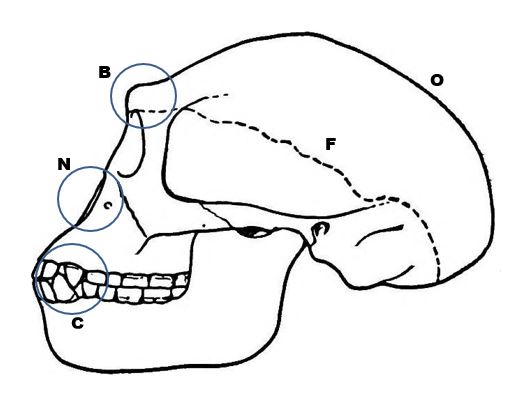Originally posted 10/08/18 on TheEvolutionOfHuman.com, the precursor to HLGTW.com
If you know where to look, the internet has some very interesting bookshelves, like the basement of a dank library. I don’t even remember what I was researching recently, when I found myself browsing through the 1921 textbook, “Readings in Evolution, Genetics, and Eugenics” by Horatio Hackett Newman (I swear I’m not making up these names). On p. 87 (p. 113 of the copy) is this sketch of “The Java ape-man, Pithecanthropus erectus.” I knew that Java Man had originally been called Pithecanthropus erectus and later reclassified as Homo erectus, though I had never quite understood why.

Now, I’m no paleontologist, but I have been researching Homo erectus quite a lot lately, and I could spot in a moment that this skull didn’t look right. And what was that dashed line? Two major facial features didn’t make any sense. Look at those canines! (C, below) Those are “honing” canines. Chimps, gorillas, and other apes have them, but our hominin ancestors lost them at least 6 million years ago. What were they doing here on a Homo erectus less than a million years old? Second, where is his nose?! Homo erectus had a projecting nasal bone like we do. This representation shows a concave nose like an African ape (N). Even for an armchair paleoanthropologist like me, these features stood out as oddly as if someone had drawn a tail on a modern human.

It occurred to me that the face must have been a guess. The dashed line was probably a fracture (F below). If Eugene Dubois, the scientist who discovered Java Man, had only the skullcap to work with, then he would be impressed by the oblong skull (O) and the heavy browridge (B). These are definitely ape-like (chimp / gorilla) features. It would only be logical for Dubois to assume — falsely, as it turns out — that the rest of the face was ape-like too.

Not much later, by chance, I happened upon a photograph of the Java Man skull. Here it is. The break is shaped a little differently, but indeed, it’s only the skullcap!

Dubois was especially perplexed to find this skullcap with an upright thigh bone. That’s why he named it Pithecanthropus erectus, “erect ape-man”. He was envisioning creatures like you’d see on “Planet of the Apes”. Later discoveries revealed the mistakes, and this species was reassigned to Homo, the human genus. The resulting term Homo erectus, “erect human”, is redundant and does not describe anything special. Like non-honing canines, we now know that erect bipedality goes back to the very first hominins.
I am interested in the history of ideas as well as the history of reality. That’s why I found it such a thrill to discover this rare textbook illustration reminding us of yester-century’s forgotten assumptions.
For further reading, I discuss hominin evolution in How Life Got This Way Chapter 7. Chapter 6 covers early humans, including Homo erectus.